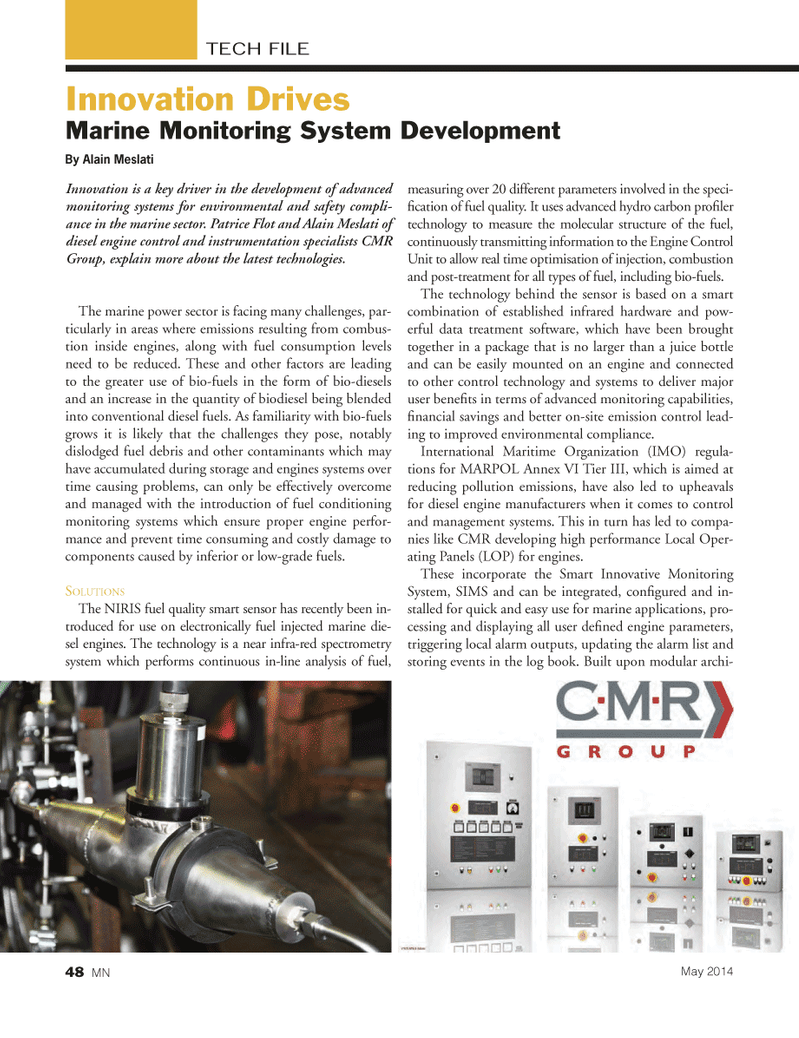
Page 48: of Marine News Magazine (May 2014)
Offshore Annual
Read this page in Pdf, Flash or Html5 edition of May 2014 Marine News Magazine
TECH FILE
Innovation is a key driver in the development of advanced monitoring systems for environmental and safety compli- ance in the marine sector. Patrice Flot and Alain Meslati of diesel engine control and instrumentation specialists CMR
Group, explain more about the latest technologies.
The marine power sector is facing many challenges, par- ticularly in areas where emissions resulting from combus- tion inside engines, along with fuel consumption levels need to be reduced. These and other factors are leading to the greater use of bio-fuels in the form of bio-diesels and an increase in the quantity of biodiesel being blended into conventional diesel fuels. As familiarity with bio-fuels grows it is likely that the challenges they pose, notably dislodged fuel debris and other contaminants which may have accumulated during storage and engines systems over time causing problems, can only be effectively overcome and managed with the introduction of fuel conditioning monitoring systems which ensure proper engine perfor- mance and prevent time consuming and costly damage to components caused by inferior or low-grade fuels.
SOLUTIONS
The NIRIS fuel quality smart sensor has recently been in- troduced for use on electronically fuel injected marine die- sel engines. The technology is a near infra-red spectrometry system which performs continuous in-line analysis of fuel, measuring over 20 different parameters involved in the speci- fi cation of fuel quality. It uses advanced hydro carbon profi ler technology to measure the molecular structure of the fuel, continuously transmitting information to the Engine Control
Unit to allow real time optimisation of injection, combustion and post-treatment for all types of fuel, including bio-fuels.
The technology behind the sensor is based on a smart combination of established infrared hardware and pow- erful data treatment software, which have been brought together in a package that is no larger than a juice bottle and can be easily mounted on an engine and connected to other control technology and systems to deliver major user benefi ts in terms of advanced monitoring capabilities, fi nancial savings and better on-site emission control lead- ing to improved environmental compliance.
International Maritime Organization (IMO) regula- tions for MARPOL Annex VI Tier III, which is aimed at reducing pollution emissions, have also led to upheavals for diesel engine manufacturers when it comes to control and management systems. This in turn has led to compa- nies like CMR developing high performance Local Oper- ating Panels (LOP) for engines.
These incorporate the Smart Innovative Monitoring
System, SIMS and can be integrated, confi gured and in- stalled for quick and easy use for marine applications, pro- cessing and displaying all user defi ned engine parameters, triggering local alarm outputs, updating the alarm list and storing events in the log book. Built upon modular archi-
Innovation Drives
Marine Monitoring System Development
By Alain Meslati 48 MN
May 2014
MN May14 Layout 32-49.indd 48 4/21/2014 10:33:55 AM

 47
47

 49
49
